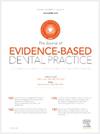低强度光治疗对口腔扁平苔藓患者疼痛和相关病变的影响:一项系统回顾和荟萃分析
IF 4
4区 医学
Q1 DENTISTRY, ORAL SURGERY & MEDICINE
引用次数: 0
摘要
背景:口腔扁平苔藓(OLP)是一种比较常见的免疫性粘膜皮肤病,可引起疼痛、灼烧感和生活质量差。使用低强度光疗法(LLLT)治疗OLP仍有争议。本系统综述和荟萃分析旨在系统和定量地评估LLLT治疗OLP的疗效。方法检索截至2023年2月28日的PubMed、Embase、护理与相关健康文献累积索引(CINAHL)、Cochrane图书馆和Web of Science电子数据库,以确定随机对照试验(RCTs),这些试验检验了LLLT在报告疼痛或其他结果的OLP患者中的应用。分别估计每个结果的95%置信区间(ci)的平均差(MD)或对数风险比(log RR),以确定效应大小。采用亚组分析来检测异质性的来源。采用敏感性分析检验合并结果的稳健性。采用漏斗图、Egger检验和Begg检验检验发表偏倚。采用Stata 16.0软件进行统计分析。采用RevMan 5.4.1软件绘制偏倚风险图,进行偏倚评估。结果本系统综述共纳入12项rct,其中7项纳入meta分析。在纳入的研究中,1项偏倚风险低,7项偏倚风险不明确。荟萃分析结果显示,LLLT显著提高了长期镇痛疗效(治疗后12周以上,用视觉模拟量表测量;MD = -1.20,95% CI -2.01 ~ -0.38, P <;.001),而在短期内(MD = -0.68,95% CI -1.38至0.01,P = .05)或中期(MD = -0.89,95% CI -1.96至0.17,P = .10)均未观察到显著变化。此外,LLLT改善了病变的临床严重程度(通过活检体征评分或网状萎缩侵蚀评分评估;MD = -1.13,95% CI -1.62 ~ -0.63, P <;.001)并降低复发率(log RR = -1.34,95% CI -2.30 ~ -0.37, P = .01)。两组临床有效率(以疗效指标衡量;log RR = -0.12,95% CI -0.37 ~ 0.13, P = .35)。未报告与LLLT相关的不良事件。结论llt可减轻OLP患者的疼痛,改善OLP病变的临床预后,降低OLP患者复发的可能性。未来的研究应侧重于更长的干预疗程、更大的样本量和多学科干预设计。系统评价注册:该meta分析在PROSPERO注册(CRD42023384852)。本文章由计算机程序翻译,如有差异,请以英文原文为准。
EFFECTS OF LOW-LEVEL LIGHT THERAPY ON PAIN AND RELATED LESIONS IN PATIENTS WITH ORAL LICHEN PLANUS: A SYSTEMATIC REVIEW AND META-ANALYSIS
BACKGROUND
Oral lichen planus (OLP) is a relatively common immunological mucocutaneous disease that causes pain, burning sensations and poor quality of life. The use of low-level light therapy (LLLT) to treat OLP is still debated. This systematic review and meta-analysis aimed to systematically and quantitatively assess the efficacy of LLLT in the treatment of OLP.
METHODS
The PubMed, Embase, Cumulative Index of Nursing and Allied Health Literature (CINAHL), Cochrane Library, and Web of Science electronic databases were searched up to February 28, 2023, to identify randomized controlled trials (RCTs) examining the use of LLLT in OLP patients reporting pain or other outcomes. The mean difference (MD) or log risk ratio (log RR) with 95% confidence intervals (CIs) were estimated separately for each outcome to determine the effect sizes. Subgroup analysis was used to detect the sources of heterogeneity. Sensitivity analysis was used to test the robustness of the pooled results. Funnel plots, Egger's test, and Begg's test were used to test publication bias. All the statistical analyses were performed using Stata 16.0 software. A graph of risk of bias was drawn using RevMan 5.4.1 software for the assessment of bias.
RESULTS
A total of twelve RCTs were included in this systematic review, 7 of which were also included in the meta-analysis. Among the included studies, 1 had a low risk of bias, whereas 7 had an unclear risk of bias. The meta-analysis results indicated that LLLT significantly improved long-term analgesic efficacy (over 12 weeks posttreatment, measured by the visual analogue scale; MD = -1.20, 95% CI -2.01 to -0.38, P < .001), whereas no significant changes were observed in either the short term (MD = -0.68, 95% CI -1.38 to 0.01, P = .05) or the medium term (MD = -0.89, 95% CI -1.96 to 0.17, P = .10). Furthermore, LLLT improved the clinical severity of lesions (as assessed by the biopsy sign scores or reticular atrophic erosive scores; MD = -1.13, 95% CI -1.62 to -0.63, P < .001) and reduced the recurrence rate (log RR = -1.34, 95% CI -2.30 to -0.37, P = .01). Additionally, there were no statistically significant differences in the clinical response rate (measured by efficacy indices; log RR = -0.12, 95% CI -0.37 to 0.13, P = .35). No adverse events related to LLLT were reported.
CONCLUSION
LLLT appears to alleviate pain, enhance the clinical outcomes of OLP lesions, and lower the likelihood of relapse in OLP patients. Future research should focus on longer intervention courses, larger sample sizes, and multidisciplinary intervention designs.
SYSTEMATIC REVIEW REGISTRATION
This meta-analysis was registered on PROSPERO (CRD42023384852).
求助全文
通过发布文献求助,成功后即可免费获取论文全文。
去求助
来源期刊

Journal of Evidence-Based Dental Practice
DENTISTRY, ORAL SURGERY & MEDICINE-
CiteScore
6.00
自引率
16.70%
发文量
105
审稿时长
28 days
期刊介绍:
The Journal of Evidence-Based Dental Practice presents timely original articles, as well as reviews of articles on the results and outcomes of clinical procedures and treatment. The Journal advocates the use or rejection of a procedure based on solid, clinical evidence found in literature. The Journal''s dynamic operating principles are explicitness in process and objectives, publication of the highest-quality reviews and original articles, and an emphasis on objectivity.
 求助内容:
求助内容: 应助结果提醒方式:
应助结果提醒方式:


